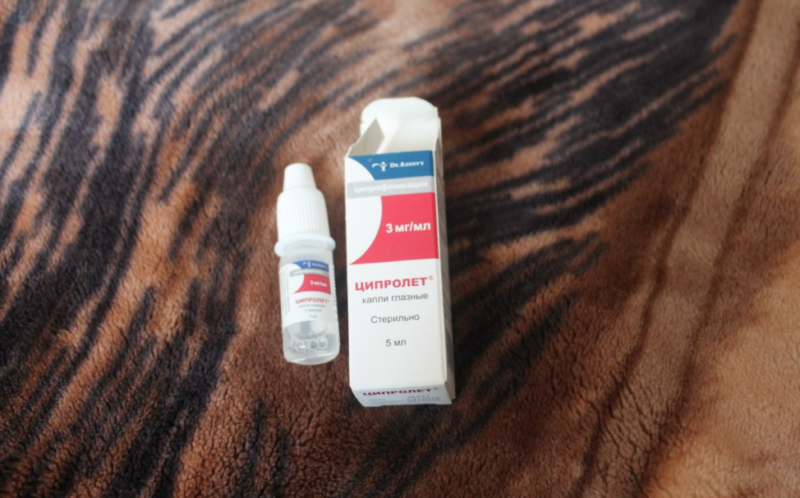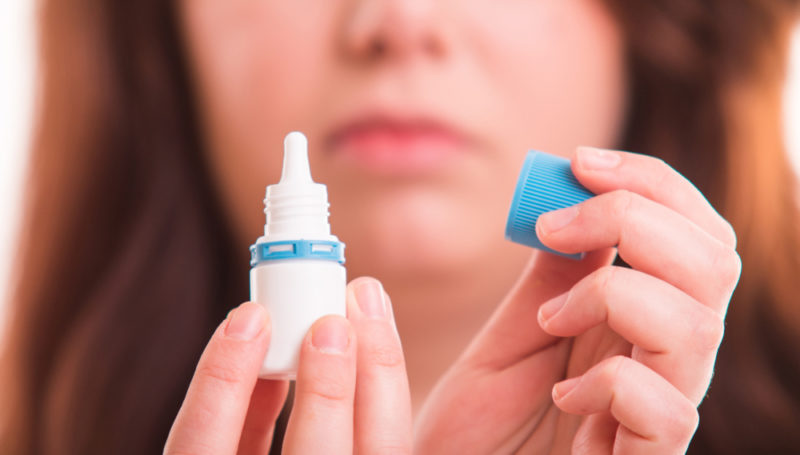If the eyes are constantly watery, painfully react to touch or blinking, then most likely they undergo an inflammatory process caused by bacteria. Cyprolet - eye drops that help not only relieve pain, but also completely destroy the infection without losing sight.
Material Content:
The composition of the drug
In its chemical state, Ciprolet is a derivative of the substance fluoroquinolone and is characterized by a pronounced antimicrobial effect.
In the world, the medication is known as “ciprofloxacin” and in 1 ml contains:
- active substance - 3.49 mg of ciprofloxacin hydrochloride (3 mg / 1 ml in dry form);
- auxiliary components - mannitol, sodium acetate, benzalkonium chloride, distilled water.
Ciprofloxacin as an active substance is an antibiotic, therefore, it can be effectively used to fight bacteria of different nature, stopping and preventing inflammatory processes.
On sale, the medicine can be found in plastic bottles with 5 ml droppers, which are packaged in standard cardboard packages. Drops are sold without a doctor’s prescription, but they should not be used alone without prescriptions.
What are the eye drops prescribed for Ciprolet?
Since the medicine contains an antibiotic that destroys numerous pathogens, it is used as a medicine for ophthalmic bacterial infections,caused by gram-positive and gram-negative pathogens. Only fungi and anaerobes of the Bacteroidaceae family are resistant to antibiotic. If the inflammation was caused by these pathogens, then the ophthalmologist should prescribe an additional drug or change the therapy as a whole.
The antibiotic ciprofloxacin inhibits the growth and reproduction of bacterial cells, thereby stopping their reproduction and stopping the spread of infection throughout the body.
The diseases that are treated with Ciprolet drops are as follows:
- corneal ulcerative lesions;
- conjunctivitis;
- inflammation of the eyelid;
- keratitis;
- chronic diseases of the lacrimal sacs.
Indications for use include recovery after surgery, eyeball injury and the ingestion of a foreign object. The antibiotic acts bactericidal and prevents the development of inflammation in it.
Instructions for use and dosage for children and adults
The drug can not be injected or injected directly into the pupil, at this time also should not wear contact lenses. Eye drops for children Tsiprolet allowed for use from the first year of life, since the safety of the drug for infants is not established exactly.
Application differs depending on the diagnosis:
- With an infection in a mild form - 1-2 drops are dropped into the eye every 4 hours.
- In case of complicated and prolonged illness - 2 drops every hour. As soon as the condition of the organ improves, the patient can reduce the dosage.
- With a bacterial ulcer on the cornea of the eye - on the first day, 1 drop every 15 minutes for 6 hours, after which 1 drop every half hour, except for sleep time. On the second day - 1 drop every 60 minutes, from 3 to 14 days - 1 drop every 4 hours.
In order to apply the drug correctly, you should:
- Prepare a bottle with a solution, pre-puncture the dropper with a sharp object.
- Lie on your back and throw your head back.
- Warm the bottle in your hands a little, because cold drops are worse absorbed into the tissue.
- Pull the edges of the lower eyelid with one hand so that a conjunctival sac forms.
- Turn the bottle over and gently squeeze the right amount of solution into the eye.
- After instillation, keep your eyes closed for 2 minutes while lying down.
- When applying, it is very important not to get the liquid into the corner of the eye near the nose, since it will immediately get into the nasopharynx and there will be no effect.
If the ophthalmologist prescribed several drugs for treatment, then the interval between instillations should be at least 5 minutes, otherwise their effectiveness will be significantly reduced.
During inflammation in patients, the clarity of vision is usually impaired, so during this period it is not worth driving or using heavy machinery.
During pregnancy and lactation
The antibiotic ciprofloxacin penetrates all cytological barriers, including through the placenta, therefore, it can affect the fetal development. Due to the humanity of experiments on pregnant women was not performed, but they were not recommended to use Ciprolet for treatment while expecting a baby, especially in the first trimester, when the fetus is especially vulnerable.
During lactation, you should also refrain from using this medication, since it penetrates into breast milk and into the body of the baby, having a negative effect on it.
Drug Interactions and Alcohol Compatibility
Ciprolet contains a strong antibiotic ciprofloxacin, the effect of which, when combined with similar substances (antibiotics), is enhanced.
Synergism is observed during the treatment of streptococcal, anaerobic and staphylococcal infections with the simultaneous use of Ciprolet and the following substances:
- beta-lactam antibiotics;
- metronizadol;
- meslocillin;
- vancomycin;
- clindamycin.
Ciprolet cannot interact with substances in which the acidity is equal to or exceeds pH 3-4, or they contain chemically unstable elements.
Like any antibiotic, ciprofloxacin is not recommended to be combined with the intake of drinks containing alcohol. In addition to the fact that the body is undergoing a tremendous load on internal systems and organs (in particular, the liver suffers greatly), it does not have time to recover and effectively fight the infection. Antibiotics negatively affect the gastrointestinal mucosa, alcohol, in turn, provokes copious secretion of gastric juice (with a high content of sulfuric acid), which ultimately leads to ulcerative lesions of the gastrointestinal mucosa.
Contraindications, side effects and overdose
Ciprolet drops are recommended to be used from 1 year of age, but parents of children under 12 years of age should first consult a pediatrician.
Among other contraindications:
- allergic sensitivity to the components of the drug;
- keratitis caused by a virus;
- pregnancy or breastfeeding.
Ophthalmologists recommend the use of drops with caution in patients who are diagnosed with atherosclerosis of the blood vessels or impaired blood circulation in the brain. In addition, patients who often have cramps should use the drug under the supervision of a health care provider.
Among the side effects after taking Ciprolet are:
- itching and burning in the eye area;
- swelling;
- photophobia;
- increased lacrimation;
- keratitis;
- allergic reaction (nausea, bad taste in the mouth).
An overdose of the drug in compliance with the therapeutic norms of its use and proper use was not observed. However, if after instillation (or accidentally swallowing the solution) the patient has nausea or a headache, then he needs to empty his stomach, take absorbent drugs and drink plenty of fluids. In case of severe discomfort in the eyes, rinse with plenty of running water and seek medical help.
Analogs
Medicines can have the same composition (structural analogues) or a similar therapeutic effect. A variety of medicines allows the doctor to choose the right treatment option for quick and effective treatment.
Tsiprolet drops also have structural analogues:
- Cypromed;
- Ciprofloxacin-AKOS.
Among the analogues in therapeutic effect, there are a number of eye drops with a broad spectrum antibiotic in the composition:
- Oftaquix;
- Toradex;
- Signicef;
- Ophthalmodec.
Ciprolet is an antibiotic eye drop used to treat ophthalmic infections and inflammations. Due to the point effect on the site of inflammation, the antibiotic quickly stops the growth of bacteria, which speeds up the healing process several times. Vision is a wonderful gift, so you need to take care of it and take care of your eyes!


















